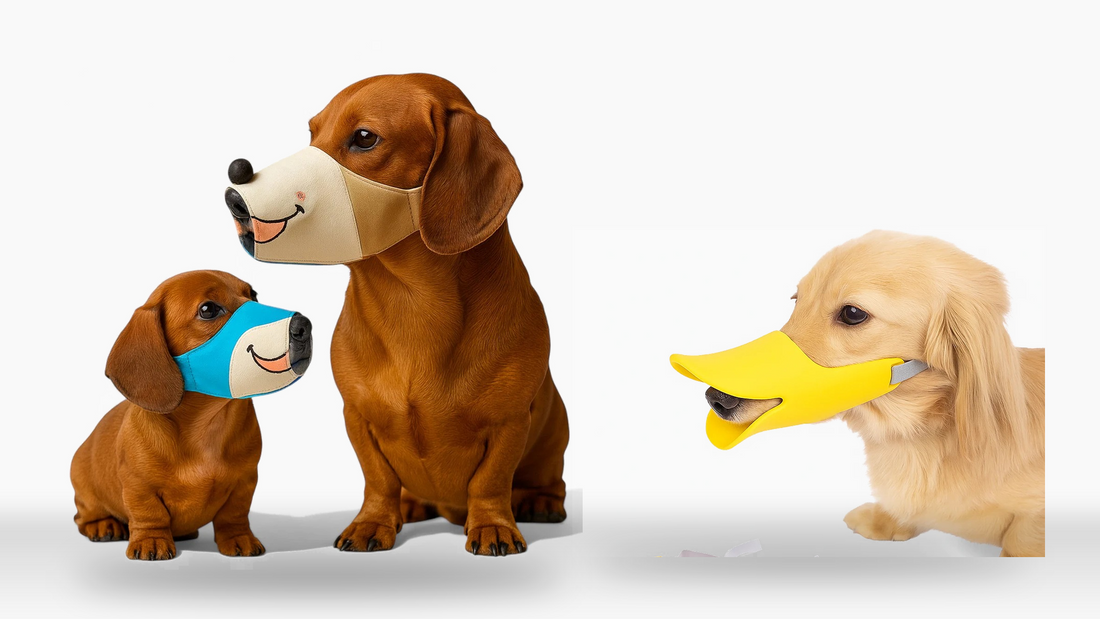
Dachshund Muzzle Training: A Gentle, Stress-Free Guide
Compartir
If your Doxie freezes at the vet, hates nail trims, or snaps when frightened, you’re not a bad owner—you’re overwhelmed. Muzzles look harsh, but with the right approach, they become a comfort cue, not a cage. Here’s how to teach it kindly so your dog feels safe and you breathe easier.
Listen to the latest episode about the Doxie Muzzle Training on Spotify
Bold, curious, and gloriously opinionated, Dachshunds feel life in HD. New sounds and handling can flip them from cuddly noodle to “nope!” in a blink. That’s why Dachshund muzzle training matters: it protects everyone during stressful moments while giving your Doxie a predictable routine that feels safe. When taught with food, choice, and short sessions, a muzzle becomes a soft signal—“good things happen now.” You’ll prevent rehearsal of bites, reduce vet/grooming anxiety, and keep training on track even when pain or fear shows up. Think of it as a seatbelt for tricky moments: rarely needed, always reassuring.
1) Pick a basket muzzle that actually fits (comfort & airflow)
Measure twice: snout length (tip of nose to stop) and circumference (just below the eyes). Add ~1–1.5 cm so your Doxie can pant, drink, and take treats. A basket muzzle for Dachshunds should allow tongue movement, yawns, and a straight shot for pea-sized rewards. Check strap placement: it should anchor behind the head without creeping toward eyes or ears; a keeper strap can prevent slipping. Prefer smooth, skin-friendly materials (silicone, biothane, coated wire) and a quick-release buckle you can handle under stress. Test fit with no pressure: you should slide one finger under the rim and see relaxed whiskers—not squish. Pad hot spots (bridge of nose, cheekbones) with moleskin if needed. Fit with the whole outfit—harness, coat, even glasses—so nothing rubs once you’re outside. Take a short fit-check video and scan for yawns, pawing, or head tosses—signals to loosen or try a different size. A dialed-in fit makes every later step of Dachshund muzzle training smoother and safer.
🎁 Pro Tip: Check out our Dachshund Silicone Muzzle – soft, flexible silicone with generous airflow so your Doxie can pant and take treats comfortably.
2) Make the nose-in cue irresistible (positive reinforcement)
Build “choice first.” Hold the muzzle like a bowl and rain six to eight tiny treats into the basket. The moment your Dachshund investigates, mark (“Yes!”) and let them back out. Repeat until the dog chooses to poke their nose in smoothly; then start paying only when the nose crosses the rim. Keep sessions tiny: 8–12 reps, 60–90 seconds total. Vary the cuisine (kibble dust, cheese bits, lickable tube) so the basket smells like a snack bar. If your dog hesitates, make it easier—raise the basket to their nose level, angle it so the opening faces them, and lower treat difficulty. Name it “Muzzle” once the behavior is reliable, then pay for one-second holds before you ever touch a strap. Avoid pushing or trapping the nose inside; that trades speed for suspicion. Your early goal isn’t wearing—it’s emotion. You want tail neutral, body loose, and eyes soft. When your Doxie starts shoving in with gusto, jackpot once, end the session, and bank the win for tomorrow.
3) Turn Dachshund muzzle training into a calm chin-rest game (duration building)
Now shape stillness. Feed in position—one treat per quiet second while the nose is parked inside. Count “one…two…three,” then remove the muzzle before your Doxie makes that “I’m done” face. If you end first, trust builds fast. Next, gently touch the strap, feed; lift strap, feed; set strap down, feed; remove muzzle, party. Break steps into micro-moves so nothing feels sudden. Aim for 5–10 calm seconds before the first brief buckle. First buckle = one second, heavy pay, off. If pawing appears, you skipped a rung—back up to shorter holds and higher reward rate. Keep your hands soft and predictable; exhale slowly to avoid telegraphing tension. Mix easy reps (no strap) with a few harder ones (strap touches), so the challenge never stacks. Add a release cue (“All done”) and toss a reset treat away from you; your dog returns to say “Let’s go again,” which confirms consent. Two or three mini sessions a day beat one long grind and help the behavior stick.
4) Add movement & touch reps (desensitization for vet/grooming)
With the muzzle on, rehearse tiny handling slices your Doxie will face later. Lift a paw for one second, feed. Touch a nail with the back of clippers, feed. Peek in an ear, feed. Count breathy beats, not minutes. Sprinkle one or two “easy wins” between each harder rep so confidence stays high. Practice three gentle hugs around chest and shoulders (like a tech’s hold), then release and treat. Add low-stakes motion: step onto a mat, hop off, walk three steps down the hall, ride the elevator one floor, stand on a bathroom scale—always feed after the move, not before. Pair a soft verbal routine (“muzzle on, treats flow, touch, end”) so the sequence becomes predictable. If sensitivity spikes, swap to a “find-it” treat scatter to drain tension, then finish. Keep tools visible between sessions so they lose their novelty. A few calm, successful reps today are worth more than a heroic push.
🎁 Pro Tip: Check out our DachCarry Dachshund Side Carry Backpack – a hands-free, snug perch that keeps transitions short and stress low.
5) Generalize to real life (walks, guests, travel with no-pull harness)
Schedule one ultra-boring “muzzle walk” weekly: quiet route, short duration, steady snack drip. That teaches your dog the muzzle predicts calm, not chaos. For doorbell practice, pre-load a treat station. Muzzle on → cue “Go to mat” → feed five quick treats → release before arousal spikes. When hosting guests, start with distance: your Doxie muzzled, on a comfy mat, snacking for looking away from people. If they fixate or huff, increase distance, decrease duration, and add sniff breaks outside. In the car, rehearse buckling the muzzle, clipping into a crash-tested setup, and settling with a lick mat—first with the engine off, then idling, then short drives. Keep a tiny training log (date, duration, difficulty, demeanor) so you know when to raise criteria. Finally, build a maintenance habit: two easy muzzle reps on random “good” days so the skill doesn’t only predict hard moments. Pairing with a no-pull harness for Dachshunds reduces leash frustration, helping your dog stay under threshold while learning.
🎁 Pro Tip: Check out our WagFree No Pull Doxie Harness and Leash Set – smoother walks mean calmer training.
Conclusion
When you teach a muzzle the kind way—choice first, food forward, and time-limited sessions—you’re not “masking” problems; you’re creating a reliable safety tool that keeps everyone calm enough to learn. The payoff is huge: routine nail trims that don’t spiral, vet care you can actually complete, family and guests who feel safe, and a small hound who trusts your hands because the pattern is always the same—muzzle on, treats flow, gentle touch, end on a win. Keep your steps tiny, track progress in seconds not minutes, and revisit earlier stages anytime life gets loud. With a steady plan and the right gear, Dachshund muzzle training becomes a confidence ritual your Doxie understands: “this means snacks, patience, and predictable care,” not a battle. That clarity lets your spicy little detective relax, so you both get what you want—less drama, more done, and a stronger bond every week.
Related Articles
- Why Every Doxie Needs a Dachshund Car Safety Bed for Travel
- How To Pick the Best Backpack Carrier for a Dachshund
- How to Safely Travel and Camp with Your Dachshund in Summer 2025
Want more Doxie-smart tips? Browse the full blog at HERE!
